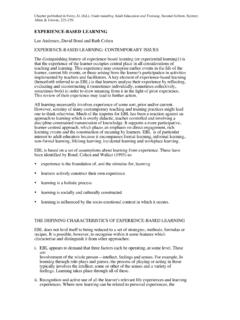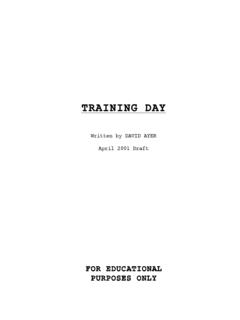Transcription of Cycling-Specific Leg Strength Training - Cyclesport Coaching
1 Cycling-Specific Leg Strength Training There are a lot of theories on Strength Training for cycling out there, and unfortunately not a lot of science to back them up. Therefore, the following Strength Training recommendations below are based on my reading of a lot of literature, books and articles on this topic. I ve put together my thoughts on what should be a sound and effective Strength Training program for cycling . At the very least, I don t believe it will hurt and should help. What I m referring to here is leg Strength Training .
2 This article does not cover upper body and core Strength . Those are important as well, but will not be addressed here. Rationale for Strength Training : Some people argue that Strength Training is not necessary for cyclists. They say that cycling relies mostly on cardiovascular fitness and you can get all the leg Strength you need by riding. They also claim that off-the-bike Strength Training is not Cycling-Specific therefore useless. While I agree that cycling is first and foremost a cardiovascular sport, leg Strength is still important.
3 cycling is a power sport. Power equals force times speed. Force is the amount of effort you put into the pedal stroke and speed is your leg rpm. Here s why I disagree who say Strength Training is not required, and why I believe it should be part of a cycling Training program. First, cycling requires leg Strength . Stronger cyclists who can continuously crank out more power must also put out more force per pedal stroke. If two cyclists are pedaling at 90 rpm and one is putting out more power, he must be putting out more force on the pedals and using more Strength to do so.
4 Power = Strength x speed. If leg speed is equal then the only other variable is force, which is driven by leg Strength . You can work on increasing your cadence, but there is a ceiling on how fast you can pedal, so your main power improvement from increased cadence is limited. The more force you can continuously generate, the more power you can put out. Strength => force. The upward limit of Strength is much more open ended than leg speed. Therefore you should work on Strength . Riding a bike will give you a lot of the Strength you need to ride well.
5 However, there are times when you could use more Strength to turn the pedals, such as when you are accelerating, charging up a hill or sprinting. It is possible but difficult to build this type of Strength just on the bike. During the summer I typically recommend doing one Strength workout on the bike each week, to maintain leg Strength . But in the off-season, I believe it is a good idea to do some gym leg Strength work. You can build more Strength in the gym than you can on a bike. Even if Strength Training isn t necessary, it is certainly more efficient and time-effective to work on Strength Training off the bike.
6 Secondly, Strength Training has the added benefit of increasing bone Strength . There is some suggestion that cyclists have less bone Strength than other athletes, perhaps due to the lack of impact (such as from running) and resistance Training . It may also be due to all the sweating that cyclists do, which can leach calcium from the body. Whether or not this is true, there s no doubt that resistance Training can improve bone Strength as well as muscular Strength . A third reason for doing Strength Training is that you can work on muscles that don t get used during cycling , or at least not very much, and therefore you can become more balanced.
7 cycling is a linear sport we tend to move our legs in one plane and use only some of our leg and hip muscles. Fourth, a rationale for doing Strength Training in the off-season is that for those of us who live in a northern climate, riding outside during the winter is difficult and often impossible. Strength Training a couple times a week gives a great workout indoors and adds some diversity to your annual Training routine. It can also simulate the effect of a long ride. The day after a good leg Strength workout your legs should feel like you ve just ridden 70 miles.
8 Finally, as you age, it becomes difficult to maintain muscle mass, even with Training . You tend to lose your type II muscle fibers (the fast twitch ones) the most, and these are the same ones built most by Strength Training . If you don t lift fairly heavy weights, you will likely lose muscle mass as you age even if you continue to ride a bike. Types of Leg Strength Training : cycling requires several types of leg Strength . It mostly requires Strength -endurance, which is the ability to push the pedals around powerfully, for long periods of time.
9 It also requires pure Strength the Strength required to push very forcefully on the pedals when accelerating, climbing or sprinting. cycling also requires you to have the ability to generate a force quickly. Think about the pedal stroke. The majority of the force to turn the cranks is generated from the 1 o clock position to the 5 o clock position (when looking at the right leg from the right side of the bike). This is one third of the pedal stroke. If you are pedaling at 90 rpm, you are doing revolutions per second, or doing one revolution in 2/3 of a second.
10 Therefore, you are generating all the down force during a pedal stroke in of a second (1/3 times 2/3). That s quite fast! Therefore, it s important to consider some leg speed work, both with and without resistance, to train your muscles to fire quickly. So we have Strength -endurance, max Strength and Strength -speed to think about. Muscle groups required for cycling : In cycling , there are four basic muscle actions involved in a pedal stroke. 1) knee extension 2) hip extension 3) knee flexion 4) hip flexion.




![This is [Synora Jones] from CMS and myself and [Kellie ...](/cache/preview/4/b/b/1/7/0/a/0/thumb-4bb170a060e61e8f21cf44a3419a7374.jpg)





